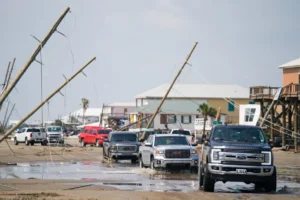Expect power outages to happen more frequently.
With Enron not around anymore taking electricity customers hostage, most outages are caused by weather events, which are becoming more frequent and extreme due to climate change. America’s power grid isn’t prepared for that.
Weather takes out power in a variety of ways, beyond wind knocking over power poles (photo below). For example, floodwaters can knock out ground-level transformers, ice can bring down power lines, and heat waves can melt cables as occurred in Oregon this summer (see story here).
Biden’s 10-year infrastructure spending bill includes $65 billion for grid upgrades, but that’s not nearly enough. America’s power grid is ancient and creaky, parts of it dating back to the 1940s. It wasn’t designed for a wired world with much higher power demand, or the warming world we’ll inevitably be living in. At this point, a switchover to “green” energy and other climate policies, even if enacted, can only slow the pace of warming, not halt it altogether.
Parts of the existing grid are so old that a Colorado engineering professor called the fact it works at all “magic.” He says, “Unfortunately, we’re going to have to get used to more blackouts. They’re just going to be a function of the aging infrastructure and climate change.”
Texas, which long ago chose to go it alone instead of tying into the national grid, arguably has the country’s least reliable electricity. Hundreds of its residents paid for that policy with their lives during last winter’s Big Freeze while their U.S. senator, Ted Cruz, sat it out in the warmth of a Mexican resort.
In my neighborhood, a handful of homes have backup generators, which have already switched on four times since mid-October, and it isn’t even officially winter yet. (I can here them running when I go for my daily exercise walks.) Here, gusty winds bringing tree branches down on power lines is the usual culprit. (For a story about Seattle’s “weather whiplash,” go here.)
For a primer on home backup generators, go here. I suspect these will become more popular, despite their cost, as the frequency and length of power outages grows. They especially make sense in rural areas, where it can take days or even weeks to restore power, which is a real problem when it occurs during the darkest and coldest (or hottest) times of the year.
What this story seems to be saying is the electrical grid will become increasingly unreliable, which is another argument for biting the budget bullet and getting a backup generator.
Photo: Expect to see more of this as the planet keeps getting warmer and weather more extreme
For an educational film about power grids, watch the 16-minute video below.
